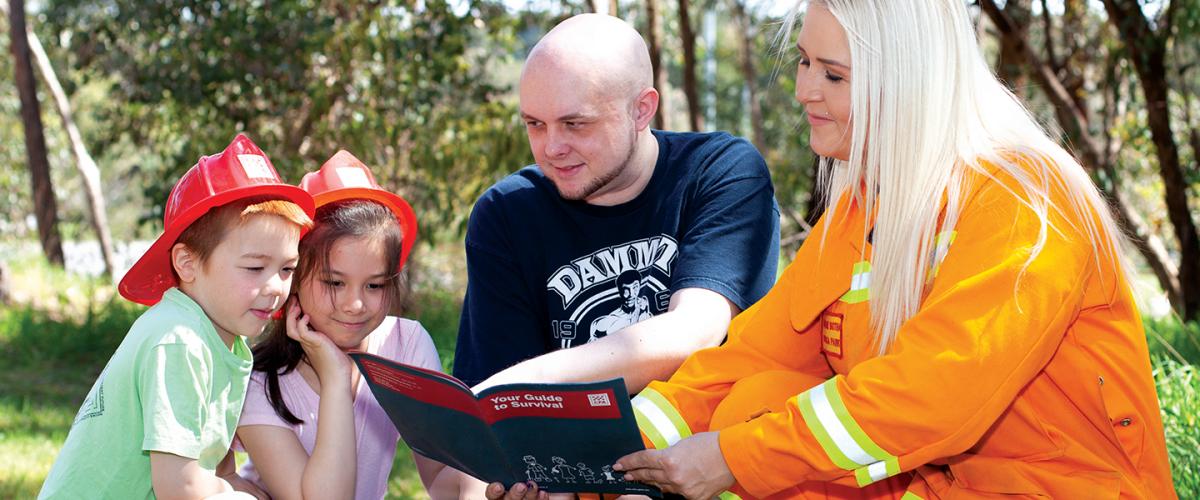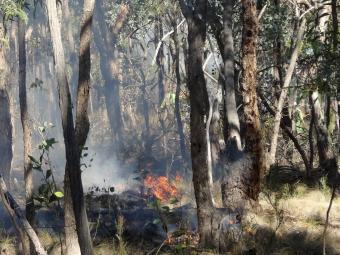On 17 November 2020, Manningham Council and guest speakers from multiple emergency services conducted the Emergency Aware Community Forum to help our community prepare for an emergency event.
Topics covered include:
- Council’s role within the emergency management space
- Fire mitigation activities undertaken by Council and Forest Fire Management Victoria
- How to prepare for Flood and Storm
- Preparing for fire Guest speakers included the State Emergency Service, Country Fire Authority, Fire Rescue Victoria, Forest Fire Management Victoria and the Warrandyte Community Association.
Jump to these topics
Know your risk
“I live in a bushfire prone area that borders a suburban area, am I still at risk?”
You are still at risk. You can never rely on what direction a bushfire will approach or location a bushfire may ignite. Bushfires can start quickly and threaten lives and homes within minutes.
A relatively short distance may take an extended period of time to vacate if roads have been impacted.
“I live in an area where there is only one major road I can use to evacuate.”
Some locations within Warrandyte, Wonga Park and Park Orchards (but not limited to) provide a single main road as the only option for entering or leaving an area. Roads that contain a high number of roadside trees stand a higher chance of being impacted during a fire or storm.
If you live in or are visiting an area of high vegetation and limited road access what events could prevent you from safely evacuating during an emergency?
- A fallen tree over the road
- Traffic congestion and/or accidents
- Emergency service vehicles attempting to reach the impacted area in high traffic
- Reduced visibility from smoke
- Flooded roads
- Panic
Leaving early to increase your chance of avoiding the above risks is your safest choice. You can monitor what roads have been impacted on VicTraffic.
“I live in an area with a high volume of roadside trees/vegetation.”
Council undertakes maintenance for our reserves and roadside vegetation to reduce risk but it is not possible to remove all roadside vegetation.
If a tree is obstructing a road, overhanging or of ill health you can report the issue to us.
If a tree has fallen on your home or is blocking access to your property you can call the State Emergency Service on 132 500.
Consider how roadside vegetation may impact your ability to safely evacuate during an emergency when making your emergency plan.
“Am I still at risk if I live on top of a hill?”
Yes, you are still at risk. A flash flood occurs after a massive downpour of rain in a short period of time. Even if your property is on an incline or at the top of a hill water may still run through your property during a flash flood event. High winds and hail can impact your property regardless of where it is located during a storm event.
In the event of a fire, fire will burn faster uphill. This is because the flames can easily reach more unburnt fuel in front of the fire. Radiant heat pre-heats the fuel in front of the fire, making the fuel even more flammable.
If you live on top of a hill or incline prepare an emergency plan that suits your circumstances.
“There is an unmaintained property in my street that may be a fire hazard.”
From November each year until the end of the fire danger period, we inspect properties to ensure long grass and any materials that may pose a fire hazard are reduced.
If there is a property in your street that is unsightly or of concern you can let us know on 9840 9333 or write us an email at manningham@manningham.vic.gov.au
“I know my risks and I am prepared.”
You can take a quick quiz to see if there is anything you can add to your emergency plan.
Sharing your home emergency plan with your neighbours may present you with additional ideas you may wish to include in your plan.
Localised knowledge from direct experience is invaluable. If you are prepared, be a community champion and share your preparedness activities with your neighbours.
“I do not live in a fire or flood prone area.”
You may be impacted by a major emergency event even if you don’t reside within a flood or fire prone area. Consider how the following potential emergency events may impact you and your family:
- Heatwave
- Thunderstorm Asthma
- Smoke and poor air quality
- Home fire
- Medical emergencies
- Damaging hail storms, high winds and flash flooding
- Disruption of essential services such as power or telecommunications
- Closure of (your) local business and infrastructure
Create a plan based on the emergency risks that could affect you.
“I have recently moved to Australia from overseas, I’m not sure what my risks are.”
If are new to Australia it is important that you know your risks.
You can access information and factsheets from the Country Fire Authority (Fire) or State Emergency Service (Flood & Storm) in multiple languages.
Residents who do not speak or understand English can communicate with Council via a direct interpreter service on 9840 9355.
Alternatively, if you require translating or interpreting services for translated information from VicEmergency or know someone who cannot speak English provide them with the following number 131 450.
“I have a disability that puts me at higher risk in an emergency.”
Research from the United Nations shows that only 20 per cent of people with a disability could evacuate immediately, without difficulty, in the event of a sudden disaster like a bushfire.
Create an emergency plan that factors your circumstances where possible and includes neighbours that may be able to provide you with assistance during an emergency. The Australian Red Cross Redi Plan may assist you in creating your plan along with this helpful guide.
For more information on preparing for an emergency if you are hearing impaired please visit the Deaf Emergency Information website.
What does your home emergency plan look like?
“I still have to make my plan.”
Consider what your state of mind would be during an emergency and how you react to stress.
Your ability to make decisions may be impaired in a high stress emergency situation. Don’t wait for an emergency. Write and rehearse your emergency plan when you are calm and in control.
Complete a Red Cross Rediplan or CFA Bushfire survival plan today, don’t put it off.
“We wrote our plan years ago, I’m not sure where it is.”
A home emergency plan is of little use if you are not familiar with it or cannot find it during an emergency.
A home emergency plan can be completed on a smart device for easy access and storage. Ensure everyone included within your home emergency plan has a copy and agrees on all its actions.
“If there was a flood or fire I would go to a shopping centre.”
Would your first choice of location change if you knew you could not return home for at least 72 hours?
Even if your home has not been damaged, you may not be allowed to return to your property for a significant amount of time until it has been declared safe by the relevant emergency service.
This is to protect your safety and may result from:
- Burnt trees that can fall with little to no warning that has historically resulted in loss of life
- Toxic flood water that may contain hazardous chemicals, broken glass or faeces. As little as 15cm of flood water can lift a car. Flood water presents a risk of drowning.
- Unsafe or damaged roads and traffic management points (TMPs)
- Your local shopping centre may have to evacuate its staff resulting in the closure of the shopping centre
“I would jump in the Yarra River if there was a bushfire.”
Sheltering in a body of water is a last resort measure to be taken when all other options have been exhausted.
Radiant heat from a bushfire can be deadly from as far as 300 metres away. You may not be able to breathe in an unsheltered location due to a lack of oxygen or heavy smoke.
Directly exposing yourself to the elements of a bushfire and adding the risk of drowning places you at high risk for trauma, injury or death.
The CFA provides further information via the Your Guide to Survival.
“I completed our emergency plan alone, if I couldn't get back home from work during an emergency my family wouldn't know what to do.”
Everyone in your household needs to be involved when creating an emergency plan. Rehearse your emergency plan with your family and neighbours regularly so everyone knows what to do. Provide easy access to a copy of your written plan by keeping copies on your electronic smart devices and hard copies in an easy to find location.
Road closures may prevent access to homes within an impacted area during an emergency event. An emergency event may impact your ability to both leave or access an impacted area. Factor the daily routines of your family members into your emergency plan.
“I would go to a family member’s home outside of Manningham.”
Staying with friends or family outside of the impacted area is the safest option if it is available to you.
You may wish to leave some essential supplies, copies of important documents or medical prescriptions at this location in the event of being displaced on short notice.
Many residents engaged in person were quick to describe their home emergency plan but did not have a clear trigger that would enact it.
Consider your risks and circumstances and ensure your trigger/s are clearly identified within your home emergency plan.
“I monitor the Fire Danger Rating and may leave on severe days or higher.”
The Fire Danger Rating is your trigger to act if you reside within a bushfire prone area. The higher the rating, the more dangerous the situation is if a fire starts. Monitor the fire danger rating regularly and keep informed on weather conditions.
On an extreme or catastrophic day, leaving high risk bushfire areas the night before or before sunrise in the morning is the safest option. Monitor the weekly forecast for Manningham via the Bureau of Meteorology to be aware of weather conditions.
“I’ll leave when I receive an emergency warning or alert to evacuate via text or landline from an emergency service.”
During a large scale emergency event, an emergency warning may be issued by the relevant emergency service (CFA for bushfire or SES for storm/flood).
Such warnings are issued to areas most at risk in a targeted fashion. It is unlikely a warning would be issued to an area as large as a municipality.
Do not wait for an emergency warning to be your only source of information or lone trigger. Emergency warnings are reliant on telecommunications technology that may be impacted depending on the event. Provide yourself as much time to react as possible by staying informed before an emergency takes place.
“I’ll leave when I receive an emergency warning on the VicEmergency app.”
The VicEmergency app is reliant on telecommunications technology that may be impacted during an emergency event. In the event of power, telephone or internet outage you can access emergency updates via an analogue battery powered radio on 774AM or 98.1FM.
Do not rely on a single method of warning.
“I’m worried that I will get stuck trying to leave if everyone is using the same trigger.”
The majority of residents engaged in person advised that their first trigger to enact their plan would be to receive a warning via the VicEmergency app on their smart device.
A resident relayed their concern that an evacuation may be prolonged if the majority of the community shared the same trigger. Leaving early is the safest option.
“I would wait until I can see smoke or flames from my driveway.”
It may be too late to leave if you wait until the impacts of a major emergency event are directly observable from your home.
Motor vehicles offer little protection from fire and driving in floodwaters is highly dangerous. Do not wait until you can see the visible impacts of an emergency before enacting your home emergency plan.
“I monitor the Melbourne Radar on the Bureau of Meteorology (BOM).”
Monitoring the BOM Melbourne Radar is an excellent tool to prepare for the impact of a storm event prior to its arrival.
Enact your plan for storm before it arrives by monitoring the Melbourne Radar.
“I regularly socialise with my neighbours, we would alert one another in the event of an emergency.”
In addition to official sources of emergency information, working with your neighbours strengthens your ability to stay informed. 40 per cent of residents already discuss their home emergency plans with their neighbours.
Start a conversation with your neighbours if you have yet to introduce yourself.
There could be a range of reasons why someone in your street may be unaware of an emergency taking place, such as:
- Do not use social media or smart mobile devices
- Do not access news from television broadcasts or internet
- Have not been monitoring emergency warning sources
- May have reading, hearing or visual impairment
- May not speak English and did not understand emergency information
- Are socially isolated and do not understand the risks
What does leaving early mean?
“I’m not sure what leaving early means.”
Leaving early means evacuating before a fire has begun. This is when the conditions for a fire that would be difficult or impossible to contain are present.
“How do I know to leave before a fire has begun?”
- Has there been a period of prolonged heat that would result a high volume of dry fuel?
- Is there going to be a number of consecutively hot days in the late thirties or early forties coming up?
- Is it a day of total fire ban?
- Is the fire danger rating severe or higher?
- Is it a day of high temperature and high winds?
- Do you have limited road access?
- Are you feeling uneasy or unsafe?
“Does leaving early mean when the fire has just reached Manningham from a neighbouring municipality?”
No, waiting until a fire has reached Manningham is too late.
Evacuation
During a large scale emergency event warnings and updates may be distributed by the relevant control agency (CFA for bush fire or SES for storm/flood) via online publications, media releases and social media posts as some examples.
Emergency warnings for community members at high risk may be sent by text message for mobile telephones or an audio message for landline telephones. This message would be to advise the community of the current level of risk. If an evacuation is required the community may be provided with a recommendation to evacuate.
Victoria has an integrated warning system which provides information and warnings to the community. The VicEmergency app watch zones can be adjusted to provided targeted information that relates to your local area. You can use VicTraffic to monitor what roads have been impacted.
“Will I be told what roads or routes to take during an evacuation?
An emergency warning may recommend those at high risk evacuate. Advice will be purposefully brief and may inform the community at risk of what road or route that has been impacted by the emergency. It is unlikely that an emergency warning will advise what specific road to take to evacuate the area.
You can use VicTraffic to monitor what roads have been impacted.
“I would like to be told what roads will be impacted by an emergency ahead of time.”
Residents cannot be advised of which road will be impacted by an emergency ahead of time due to the unpredictable nature of emergencies. Consider local road access, available routes or potential factors that may impede your evacuation when making your emergency plan.
“Will warnings tell me how to prepare my property before leaving?”
Warnings will not provide an at length checklist of tasks for you to complete to conduct your evacuation. The purpose of an emergency warning is to alert you of the level of risk and may recommend that you evacuate.
What would you put in your emergency evacuation kit?
“I have a school bag of essential items near my front door and one that stays in my car.”
It’s a great idea to have back-ups that keep you covered if you don’t have the chance to access your first choice.
“I keep copies of my important documents and some essential items at a family member’s house.”
A member of our community provided the excellent suggestion of storing essential items and documents at a family member's home. This is especially useful if this family member's home is your planned location to evacuate to during an emergency event.
“I keep copies of important documents on an encrypted portable hard drive.”
Some community members keep copies of their documents on cloud based back-ups while others feel more secure using a physical hard drive. Your emergency evacuation kit should include copies of important documents.
“When my home was flooded, my parent’s wedding album looked like one big blur of colour. I lost every photo. I wish I had scanned them.”
Heartbreakingly a woman from Templestowe shared how a flooding event took precious family photos she can never get back. Scan your family photos and keep an electronic copy.
“I have online medical prescriptions so I don’t have to worry about losing them if I had to leave my home in a hurry.”
Ask if your pharmacy can store a copy of your medical prescriptions. Online applications are also becoming increasingly available to manage your prescriptions. Make sure your home emergency kit contains a first aid kit and any medications or prescriptions you may need.
Insurance
Research from the Victorian government from 2017 estimated only 46 per cent of Victorian households insurance provides enough coverage to recover from a disaster. Consider how you would be impacted if an emergency event destroyed your property and you did not have any or adequate coverage.
Lodging an insurance claim is a stressful experience, especially if your claim is rejected for something you thought you were covered for.
“My insurance covered damage for flood but not storm. Water came in through the roof during a storm. The damage wasn’t covered.”
Many insurance policies will not provide coverage for broad terms such as ‘water damage’. Read the fine print and confirm what you are specifically covered for. Review your coverage against existing risks in your area. Make sure you have the coverage that suits your needs.
“My insurance said I was covered for storm damage but when I looked closer it was only for my fences and gates, not my house.”
Even specific headings such as ‘storm coverage’ needs to be reviewed within insurance policies. A heading may provide the impression of coverage but not cover your most valuable assets.
“My policy includes coverage for fire but heat damage is not covered. What does that mean?”
Your home can sustain damage from radiant heat without actual flames making contact, especially in a bush fire. Some exclusions, terms and conditions to be aware of include no cover for loss or damage where no flame damage has occurred, such as scorching, melting, heat, smoke, ash or soot.
Understand your coverage for bushfires.
“I have completed a valued itemised list of my assets and have taken photos of them. If I have to make a claim I know exactly what I’m claiming for.”
A member of the Park Orchards Rate Payer association shared his practice of evaluating and documenting his assets each year to minimise stress during the claim process in a worst case scenario.
Could you realistically give an accurate evaluation of everything you own from memory?
Calculate your household inventory and building assets today.
“I could purchase insurance when I get an emergency warning.”
Most insurance companies exclude coverage if a bushfire occurs less than 72 hours after you bought your policy.
When purchasing insurance consider if your coverage includes enough to rebuild or repair your home.
Who is in my street?
Start a conversation with your neighbours and share your knowledge and experiences. You can download conversation cards from the Australian Red Cross to introduce yourself.
“There is an elderly person that lives alone in my street. I check to see if they are ok during heatwaves or if it’s particularly cold in winter.”
Conducting a welfare check on someone who may be isolated during a heatwave could save a life.
Additionally, there may be other circumstances during an emergency that may place someone who is isolated at greater risk such as:
- Limited or no transportation access if an evacuation is required.
- No access to the internet or a mobile device to receive emergency warnings.
- Pre-existing health issues and/or limited mobility.
When possible include your neighbour’s circumstances into your home emergency plan.
“There may be someone in my street that has a disability.”
If you have a neighbour with a disability they may be at a higher risk of being impacted by an emergency due to:
- Impaired hearing or vision that may impact their ability to be reached by emergency warnings
- Learning or reading disabilities that may impact their ability to understand emergency warnings
- Required medical equipment such as recuperators may make evacuation difficult
- Limited mobility
Have a conversation with your neighbours regarding their or your circumstances if possible and create a home emergency plan together. A neighbour may be the first source of warning for an emergency.
"Our neighbours are new to the area and may not know the risks."
People may choose to live in Warrandyte, Park Orchards or Wonga Park because of how beautiful the areas are but may have never lived in a bush fire prone area before. Share your local knowledge with those that are new to the area about risk. This conversation may be the first time your new neighbours have considered the risk of a bush fire or flood.



